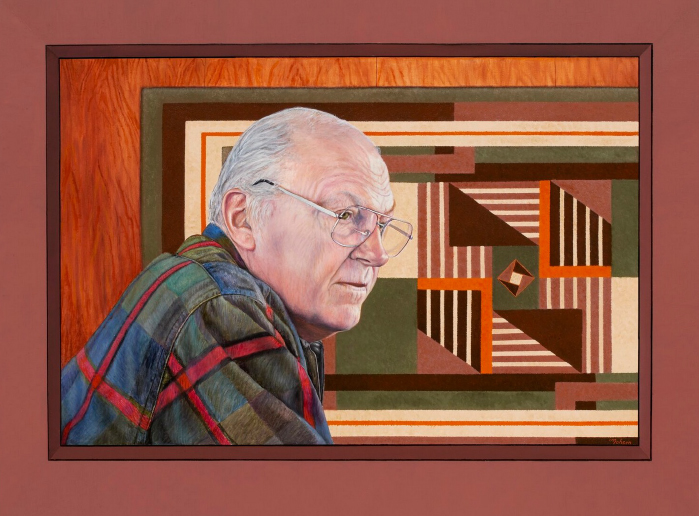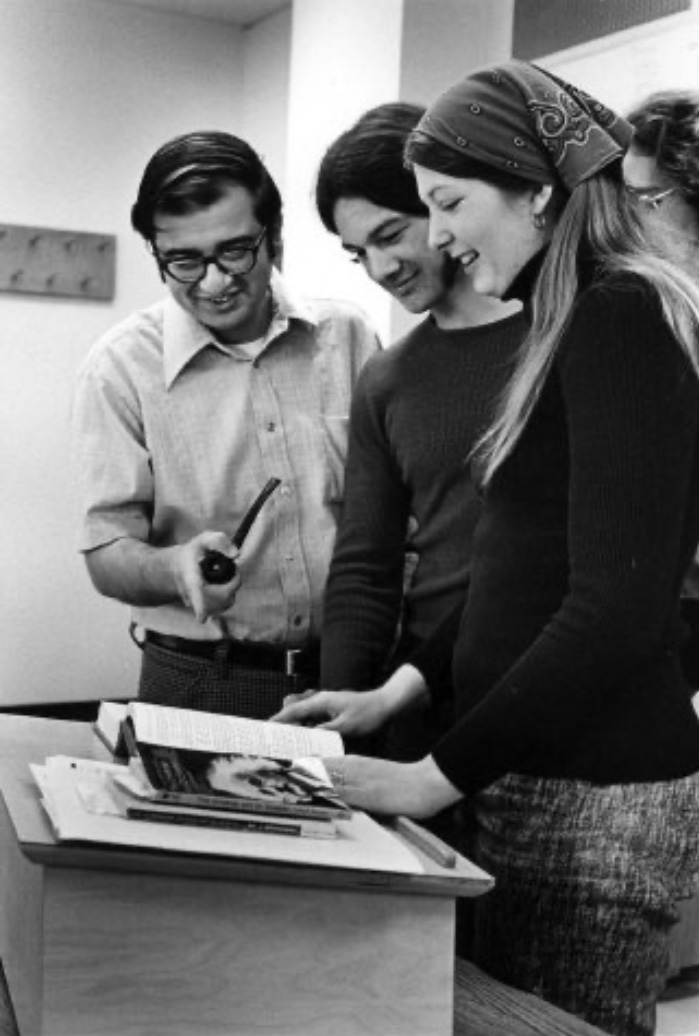
Saving CSM’s History
How four unlikely preservationists rescued priceless records so future Bulldogs may know on whose shoulders they stand
“Do you want to see some pictures? Have I got pictures!”
– Helen Souranoff to Bill Rundberg, ca. 2001
College of San Mateo’s centennial history couldn’t be told without the CSM Archives, a rich trove of photos, interviews and papers in the campus Library that documents CSM’s contribution to academic excellence and cultural life.
It is the brainchild of four improbable saviors—none of them a professional historian or archivist—who rescued priceless records from a dumpster during a 1990s remodeling and in 2001 began organizing them for access by researchers and the public.
They are Bill Rundberg, emeritus professor of mathematics; Gus Petropoulos, a former San Mateo County Community College District assistant chancellor for research and technology; former CSM Theatre manager Helen Souranoff; and then-CSM President Shirley Kelly. Only Kelly, upon assuming the presidency in 2000 and pondering its symbolic role, had ever thought much about the College’s history apart from the document find.
What the four did have, Petropoulos said, is a love of people—specifically CSM people. They wanted to record how their colleagues worked together to create the College of today.
All four had jobs that invited them to think of CSM holistically, of its role in the community and the human connections that bind it. As District Chancellor Michael Claire has often said, “We stand on the shoulders of others.”
The height at which CSM’s history now stands, however, was represented by a pile of papers in a dumpster when Helen Souranoff found it circa 1997. In the pile were thousands of images by district photographer Isago Isao Tanaka that dated back to 1964, almost to College Heights’ opening.
As a former colleague of Tanaka’s in CSM’s Media Center, which was being cleared from the Library for the remodeling, Souranoff could not bear to see his work lost.
Memories differ slightly, but all agree Souranoff and others secreted the photos in an unvisited corner of the Library for safekeeping.
Around 2001, Bill Rundberg was on a three-year post-retirement contract with Kelly’s office, working on projects like a new website for the astronomy department. He asked Souranoff if he could lay out some photos on a big table at the Theatre, which she then managed.


“I wanted to get some old photos of the planetarium while it was being built. I went over to Helen Walker in publicity to see if she had any pictures,” Rundberg said. “Helen showed me two file drawers that weren’t categorized in any way and said there might be something in there. I knew I had to look at those.”
“I went over to the Theatre. Helen Souranoff ... said, ‘Do you want to see some pictures? Have I got pictures!’”
“She walked me over to the library and showed me 15 file drawers full of photos ... tossed by someone with less vision than Helen had.
“I walked that back to Shirley and we talked about it. And that became a project that was funded at first by the College.”
Kelly recalled being drawn to campus history when she became president of the College because of her transitional role between College Heights’ midcentury eminence and the need decades later to renovate and reshape it. History was on her mind when she planned CSM’s first major building since 1963, the Integrated Science Building.
“I felt a responsibility to make that building be modern but not be a sore thumb,” Kelly remembered. “It was important to be true to the John Carl Warneke tradition and to Julio Bortolazzo,” she said, while addressing the new technology and educational philosophy that called for changes in CSM’s built environment.
“I read Michael Svanevik’s book Class Act [published in 1997 for CSM’s 75th anniversary] and it was a page-turner for me,” Kelly said. “I’d heard about Julio B. even as a chem teacher in San Francisco. What a figure he was. ... I became interested in contacting past presidents or their descendents, to get a sense of history. Until he died, I talked to [Bortolazzo] every six months or so. I talked to Betty Roehr, who was Charles S. Morris’ daughter.”
Kelly rewrote Rundberg’s contract to make him creator of the College of San Mateo Archives. He launched the CSM Historical Photograph Collection website in 2003. The site is searchable for district people and places as well as topics like nursing or football. After his contract ended, Rundberg continued working on the archive as a volunteer. By 2010, the website had 4,600 photos, most of CSM from 1963 onward but also many from Skyline and Cañada as well as CSM’s Coyote Point and downtown years.
The second phase of CSM’s historical project began with Rundberg’s and Petropoulos’ shared tenure on the district retirees’ scholarship committee.
“We were chitchatting,” Petropoulos remembered. “I said, ‘Bill, you’ve got all these photos.’ We thought, ‘There have got to be stories behind a lot of these photos.’”
So began CSM’s Oral History Archive, now at 96 interviews and counting.
“Bill, KCSM staffer Rick Zanardi, Ken Kennedy and I started using KCSM’s studio equipment to do the interviews,” Petropoulos remembered. “We’d call you in. We’d set up a lot of the old photos in a little room to maybe trigger some things you’d like to talk about. Rick would operate the camera, and one of us, whoever was most knowledgeable about that person, would do the interview. The other two would be listening in another room.”
“Later, the District office gave us a camera and we did the interviews in the Theatre with Helen Souranoff. Then we ended up with a small studio in Building 1. It’s still there, with lights.”
Rundberg, Petropoulos and others interviewed students, faculty and staff who were at CSM from the 1930s onward. Many of the subjects have since died. Their recollections are priceless records of life back then: not just at the College, but in the Bay Area generally. Interviews with people like Tanaka, and with lawyer and Tuskegee Airman Les Williams, Class of ’39 (by KCSM’s Claire Mack) reveal their resilience as activists and artists of color, and how they worked for a more equitable society.
Other interviewees, like Kelly and former Vice President of Student Services Pat Griffin, tell how education itself has changed to serve students better. As Griffin said, “We moved in community colleges from the ‘Mother and Father know best, let us tell you what you need’ [model] to asking the students what they needed and providing it.” Today, everything at CSM from hiring and curriculum to the built environment is constantly being re-evaluated to serve students’ needs.
“I like the feeling that whatever I’m part of, it’s only part,” Rundberg said. “There’s a kind of buffer of reality and possibility that surrounds each one of us, so we don’t have to have the feeling that we’re trying to break out. We’re in a larger place.”
As well as the thousands of photos of college life by Tanaka, a noted documentarian of Japanese-American life, the CSM Archives hold decades of Bulldog memorabilia including sports helmets and uniforms; planning and construction documents; yearbooks and even staff/faculty recipe collections. Alumni and retirees contribute more photos monthly, along with data that helps contextualize the holdings.
Most recently, the CSM Archives gave rise to two exhibitions at the San Mateo County History Museum in Redwood City: a Fall 2022 exhibition of Isago Isao Tanaka’s CSM photographs in the historic rotunda, and a larger exhibition opening Oct. 29, College of San Mateo: 100 Years of Making Dreams Come Through, on the main exhibit floor.

